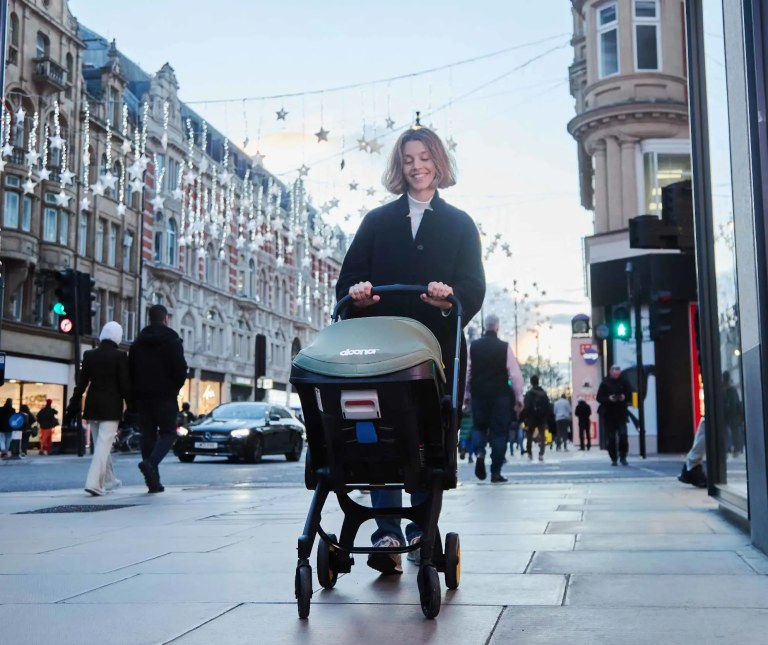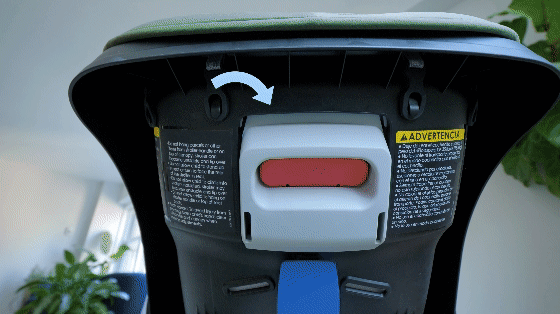
Should You Get a Doona? A Real Parent Reviews the Car Seat & Stroller Combo
Video: the Doona is a 2-in-1 that transforms from infant car seat into a stroller—here’s what to know before getting one.
By Babylist Team
Few strollers have the obsessive fan following that the Doona has. It was the first-ever infant car seat to convert into a stroller without any extra gear required (basically, it’s like Transformers, but for parents). The Doona can be installed in taxis and ride shares without a base, and as a stroller it even fits through the aisle on airplanes, making it one of the most travel-friendly rides around. In the video above, Julie, a Babylist mom of two who has lived in London and New York, tests out just how nimble this 2-in-1 gear really is. Here’s what you’ll want to know before adding the Doona to your cart (or your Babylist).
In This Article
How the Doona Works
While the Doona might be a mechanically impressive ride, it’s pretty simple to use. First of all, it comes fully assembled straight out of the box—you just unfold it and it’s ready to roll. In car seat mode, the wheels of the Doona tuck into the underside of the car seat, allowing it to attach to a LATCH-friendly base for car rides (for taxis or rideshares, you can skip the base and install it with just a seatbelt). And when you want to switch into stroller mode, you just release the wheels and extend the handlebar. If you skip to the 00:54 mark in Julie’s video, you can see exactly how the Doona transforms from car seat to stroller and back again.

Doona vs. Travel System
The Doona makes the most sense if you think of it as a souped-up car seat that transforms into a stroller, rather than a replacement for both. Often parents—especially in urban areas—will end up getting a separate stroller for when they need to handle more unpredictable terrain or for longer everyday walks, while still loving the convenience and portability of the Doona. But what if you did want to use it as your everyday ride? If you’re considering a Doona over a travel system, there are a few key differences that can make errands and neighborhood strolls easier with the Doona:
No stroller hauling: For some parents, the added task of needing to lug a stroller in and out of the trunk every time they need to run a quick errand can mean skipping the stroller altogether and just carrying a car seat carrier around by the handle—which can get really heavy really quickly. But the whole point of the Doona is that it’s a 2-in-1, which means you won’t have to deal with bringing a separate stroller everywhere you go (which also saves your trunk space for other items). This can be especially useful for parents who are in and out of the car a lot during the day—like if you’re taxiing older kids around to various activities with your baby in tow.
Rideshare-friendly: If you take rideshares or taxis often, it can be a lot to manage a stroller, car seat and baby in the minute or two you have to get everyone in the car. The ability to quickly convert the Doona into car seat mode and install without a base and then switch back to stroller mode when getting out of the vehicle can make those transitions quicker and less stressful.
Compact size: Travel systems are often sold with full-size strollers, which can get tricky when you’re trying to navigate small spaces (think: bringing your infant into a tightly-packed restaurant or strolling the aisles of your favorite bodega). Instead of having to leave your stroller outside and carry your baby, the Doona squeezes relatively easily into smaller spaces, allowing you to keep it close by. More accessibility: Because of the dual functionality of the Doona, the handle of the stroller is lower to the ground than most traditional strollers. This means it can be a bit of a reach if you’re tall. But one thing that isn’t talked about as often is that the lower handlebar height makes this one of the few strollers that is accessible for parents who use wheelchairs.
That said, comparing the Doona to a travel system is a little bit of an apples-to-oranges situation—it’s really in a separate gear category. But there are a few things you’ll want to keep in mind when using one:
Separate storage: The Doona’s wheels are where a storage compartment would normally go on a standard stroller, so you’ll need to carry a diaper bag with you when you’re out and about. Or you can buy a Doona stroller bag separately for all your baby’s swag if you want something that attaches to the stroller.
Wheels = extra weight: Because the Doona is a car seat and stroller in one, at 17 pounds the car seat itself may be heavier to load in and out of your car with a baby in it (it’s more akin to lifting a stroller with a baby in it). Particularly if you have a taller vehicle, you’ll want to make sure you can manage getting the Doona in and out of the car with your baby inside.
Longevity: Doona Height & Weight Limits
So how long can you use the Doona for? Just like a regular infant car seat, you should plan on upgrading to a convertible car seat (and a new stroller if you don’t already have one) once your baby hits the 32-inch height or 35-pound weight limits of the Doona—which is the average height of a 12–18 month old (FYI: babies tend to outgrow car seats by height before weight).
How to Install the Doona
One of the highlights of the Doona is that it can be installed in a car with or without the base, which makes it really handy for travel (not having to bring a stroller or car seat base makes packing a lot more streamlined).
The base is LATCH-enabled, so it’s easy to install in your car—you just click the Doona’s LATCH connectors to your car’s lower anchors and then tighten the slack. One nice bonus feature is that the handlebar rotates forward to act as an anti-rebound bar in car seat mode, which reduces the amount of movement on your car seat in the event of an impact. You can see that in action at the 04:10 mark in our video, or click the timestamps below to skip right to the demo of how to install the Doona:
- Installing the Doona base using LATCH (03:31)
- Installing the Doona base with a seat belt (03:47)
- Installing the Doona without a base, using only your car’s seat belt (04:35)
One pro tip: when you’re done with your drive and ready to take the Doona out of your car and transform it into stroller mode (presumably with your little one still in their car seat), release the Doona’s wheels closer to or even on the ground to avoid startling your baby.
Conclusion: Who Do We Recommend the Doona for?
If you’re planning to travel with your baby a lot, especially in the first year, the convenience of having your car seat also function as your travel stroller can’t really be replicated. And even for everyday adventures, a standard travel system isn’t for everyone! If your daily travel involves frequent rideshares, or if you are going to be in and out of the car a lot throughout the day (think: shuttling around several kids to different activities with baby in tow), this gear might be for you.
As one parent recalled, “We live in NY and this car seat/stroller combo made a cross-country trip to CA so easy. Brought this on the plane, and was easily able to use this in multiple rental cars/family cars.” It worth noting that at $550, the Doona comes in on the higher end of infant car seat prices, but you could easily spend that on a travel stroller alone without getting the 2-in-1 functionality.
So if you want a travel-friendly stroller for baby’s first year, or are simply hoping to save yourself the hassle of lugging a stroller out of the trunk every time you want to run a quick errand with your baby, a Doona might be the solve you’re looking for. Watch our complete video review to see the Doona in action.
This article is sponsored by Doona. Babylist’s free site, apps and emails are made possible by our sponsors. We limit our sponsored content to relevant partners that offer products and services we believe in and use ourselves.
